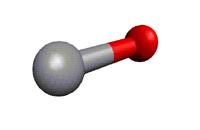|
The first entry of Jan. 2003 was based on
(1) G. Klapper, L. Surin, F. Lewen, H. S. P. Müller, I. Pak, G. Winnewisser,
2003, Astrophys. J., 582, 262.
We retain J" = 4, 6, and 7 in the present evaluation.
The J" = 0 – 3 transitions frequencies with 17O
hyperfine structure splitting were taken from
(2) G. Cazzoli, L. Dore, C. Puzzarini, and S. Beninati,
2002, Phys. Chem. Chem. Phys., 4, 3575.
The J" = 22 frequency was taken from
(3) J. C. Pearson, B. J. Drouin, A. Maestrini, I. Mehdi, J. Ward,
R. H. Lin, S. Yu, J. J. Gill, B. Thomas, C. Lee, G. Chattopadhyay,
E. Schlecht, F. W. Maiwald, P. F. Goldsmith, and P. Siegel,
2011, Rev. Sci. Instrum., 82, Art. No. 093105.
The transition frequencies should be quite reliable up to
about 2.5 THz. Great caution is advised above 3.6 THz.
Please note that the partition function still only refers
to the ground vibrational state.
The 17O HFS splitting can be resolved in some
astronomical observations. Therefore, a
separate hyperfine calculation is provided for
J" ≤ 4 below 562 GHz.
NOTE: The partition function
does take into account the spin multiplicity
of the 17O nucleus !
The dipole moment and dipole centrifugal corrections are taken from
(4) D. Goorvitch,
1994, Astrophys. J. Suppl. 95, 535.
|
